HTC Android phones sport AMOLED, new UI layer
Feb 18, 2010 — by Eric Brown — from the LinuxDevices Archive — 1 viewsHTC announced two Android phones, both featuring a new version of its HTC Sense UI layer. The HTC Desire is a modified version of the Google Nexus One (or vice versa), featuring a 1GHz Snapdragon processor and a 3.7-inch WVGA AMOLED display, and the HTC Legend is a mid-range upgrade to the Hero.
Both the high-end HTC Desire and the more modest HTC Legend offer Android 2.1 along with a new version of HTC's Sense UI layer. Most notably, the new HTC Sense offers an application called HTC Friend Stream, which is said to aggregate social communications, including Facebook, Twitter, and Flickr, into one "organized flow of updates."
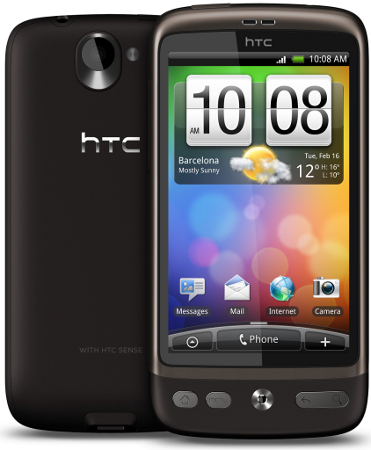
HTC Desire
(Click to enlarge)
Both phones also offer some handy sensor-related features such as automatically muting the ringer when the phones are flipped face down, or lowering the ringer volume as the phone is raised to one's ear. The Desire and Legend can also backup selected data and settings to their microSD cards automatically, such as SMS/MMS messages, bookmarks, and WiFi passwords, says HTC.
HTC Desire
The HTC Desire (formerly code-named the Bravo) is another version of the  HTC-manufactured Nexus One phone (pictured at right), which is sold by Google and T-Mobile. Said by many to exceed the Motorola Droid as the best of the high-end Android phones, the Nexus One has also suffered from some 3G reception problems that Google is working to address.
HTC-manufactured Nexus One phone (pictured at right), which is sold by Google and T-Mobile. Said by many to exceed the Motorola Droid as the best of the high-end Android phones, the Nexus One has also suffered from some 3G reception problems that Google is working to address.
The Desire and the Nexus One offer dimensions that are almost identical, with the Desire measuring 4.7 x 2.36 x 0.47 inches. Like most HTC Android phones, including the Legend and Nexus One, the Desire lacks a physical keyboard. Compared to the Nexus One, the Desire weighs a bit more, has somewhat different styling and button layouts, and adds an optical joystick.
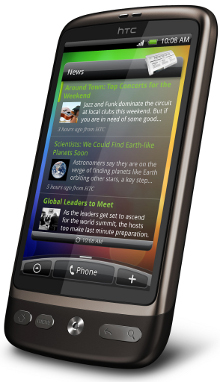
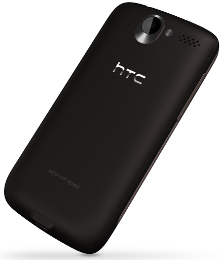
HTC Desire, front and back
(Click on either to enlarge)
The Desire stays with 802.11b/g WiFi instead of moving up to the Nexus One's 802.11n, but it offers a tad more RAM (576MB), and a bundled flash memory card that, at 8GB, is twice as large.
Equipped with Android 2.1, and sporting the aforementioned Sense UI layer, the Desire (pictured above and below right) is said to be "Adobe Flash 10.1 ready." Software includes pre-installed, integrated Facebook, Flickr, Twitter, and YouTube apps, as well as Google Maps, and its own location-based HTC Footprints app, says the company.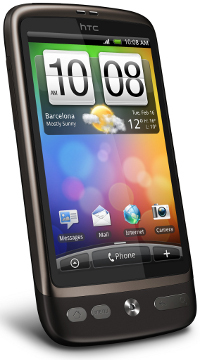
Specifications listed for the HTC Desire include:
- Processor — Qualcomm Snapdragon @ 1GHz
- Memory — 576MB RAM
- Flash — 512MB internal flash plus 8GB flash card in microSD slot that supports up to 32GB
- Display — 3.7-inch 800 x 480 AMOLED touchscreen with pinch-to-zoom
- Cellular — HSPA/WCDMA: 900/2100MHz; GSM: 850/900/1800/1900MHz
- WiFi — 802.11 b/g
- Bluetooth — Bluetooth 2.1 with EDR, A2DP, FTP, OPP, and multiple profiles
- GPS — internal antenna
- USB — Micro-USB
- Camera — 5-megapixel with autofocus, flash, face detection, widescreen, geotagging, video capture (3GP)
- Audio — 3.5mm jack; music player; FM radio
- Sensors — G-sensor; digital compass; proximity sensor; ambient light sensor
- Software (highlights):
- HTC Sense with Friend Stream
- Facebook, Flickr, Twitter, YouTube integration
- Multiple widgets
- Google Maps
- HTC Footprints (location)
- Battery:
- 1400 mAh Li-Ion
- Up to 390 min. talk WCDMA
- Up to 400 min. talk GSM
- Up to 360 hours standby WCDMA
- Up to 340 hours standby GSM
- Dimensions — 4.7 x 2.36 x 0.47 inches (119 x 60 x 11.9mm)
- Weight — 4.76 oz (135 g)
- Operating system — Android 2.1
HTC Legend
The HTC Legend is notable for its smooth, continuous surface, which is said to be "machined from a single aluminum block into a seamless compact frame." It's said Vodafone will launch the stylish Legend in April, and top off Android 2.1 and the Sense layer with its own "360" push Internet service.

HTC Legend
(Click to enlarge)
Yet the Legend is a step forward in several directions. First, its processor has moved up to an unstated 600MHz model instead of the the 528MHz Qualcomm MSM7600 used in the Hero and Eris. In addition, RAM has graduated to 384MB instead of 288MB, and the microSD slot can expand to 32GB instead of 16GB. HTC did not list the capacity of any bundled microSD card (the Eris offered 8GB), so presumably that will be left up to carriers.
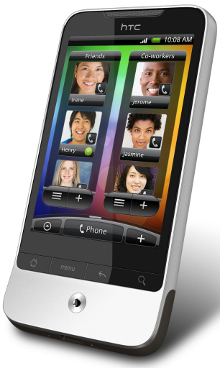
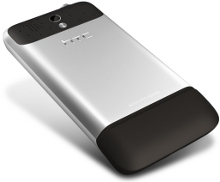
HTC Legend, front and back
(Click on either to enlarge)
As previously mentioned, the Legend offers the same Android 2.1 and updated HTC Sense UI features as are provided by the Desire. It also supplies the same sensor-related tricks, such as muting the phone when it's laid face down.
Vodafone will launch the phone with its own 360 Internet services and UI layer, which presumably will be made to work seamlessly with HTC Sense. The Vodafone 360 service is also available on its LiMo based 360 H1 and 360 M1 phones.
Specifications listed for the HTC Legend include:
- Processor — Unnamed 600MHz processor
- Memory — 384MB RAM
- Flash — 512MB internal flash; microSD slot for up to 32GB
- Display — 3.2-inch 480 x 320 AMOLED touchscreen with pinch-to-zoom
- Cellular — HSPA/WCDMA: 900/2100MHz; GSM: 850/900/1800/1900MHz
- WiFi — 802.11 b/g
- Bluetooth — Bluetooth 2.1 with EDR, A2DP, FTP, OPP, and multiple
- GPS — internal antenna
- USB — Micro-USB
- Camera — 5-megapixel with autofocus, flash, widescreen, geotagging, video capture (3GP)
- Audio — 3.5mm jack; music player; FM radio
- Sensors — G-sensor; digital compass; proximity sensor; ambient light sensor
- Software (highlights):
- HTC Sense with Friend Stream
- Facebook, Flickr, Twitter, YouTube integration
- Multiple widgets
- Google Maps
- HTC Footprints (location)
- Battery:
- 1400 mAh Li-Ion
- Up to 440 min. talk WCDMA
- Up to 490 min. talk GSM
- Up to 560 hours standby WCDMA
- Up to 440 hours standby GSM
- Dimensions — 4.41 x 2.22 x 0.45 inches (112 x 56.3 x 11.5mm)
- Weight — 4.44 oz (126 g)
- Operating system — Android 2.1
Stated Peter Chou, CEO of HTC Corp., "HTC Legend and HTC Desire take Android to another level in both substance, with HTC Sense, and style, with HTC Legend's revolutionary crafted aluminum unibody design."
Stated Patrick Chomet, Group Director of Terminals for Vodafone, "The HTC Legend, the HTC Desire and the HTC HD mini will be ranged in selected Vodafone markets across our footprint. I'm particularly pleased that through our collaboration with HTC, Vodafone customers will experience a differentiated experience on the HTC Legend which will come customised for them with pre-loaded Vodafone 360 Internet services."
Availability
The HTC Desire will be broadly available to customers across major European and Asian markets in early Q2, and will be exclusively available in Australia through Telstra, says HTC. More information may be found here.
The HTC Legend will be available in Europe through Vodafone and in the direct channel in April, and will roll out to other parts of the world, including Asia, in early Q2, says the company. More information may be found here.
The new release of the HTC Sense will be offered as a free upgrade on the HTC Hero in Europe and Asia.
This article was originally published on LinuxDevices.com and has been donated to the open source community by QuinStreet Inc. Please visit LinuxToday.com for up-to-date news and articles about Linux and open source.